Apple's 2010 MacBook Air (11 & 13 inch) Thoroughly Reviewed
by Anand Lal Shimpi on October 26, 2010 10:08 PM EST- Posted in
- Mac
- Apple
- MacBook Air
- Laptops
The SSD: Not Half Bad
Apple advertises the new MacBook Air as being instant on as a result of the internal SSD. That’s mostly untrue. From a completely powered off state the MacBook Air still takes time to boot. That time is significantly reduced compared to the old MacBook Air and any other Mac with a conventional hard drive. It’s even a shorter boot than my MacBook Pro with a SandForce SF-1200 based SSD in it:
| System Performance Comparison | ||||||
| Boot | Shut Down | Sleep | Awake | |||
| 11-inch MacBook Air | 15.5 seconds | 2.2 seconds | 1.0 second | 1.63 seconds | ||
| 13-inch MacBook Air | 14.4 seconds | 1.9 seconds | 1.0 second | 1.56 seconds | ||
| 13-inch MacBook Air (Late 2008) | 34.4 seconds | 2.9 seconds | 1.6 seconds | 4.19 seconds | ||
| 15-inch MacBook Pro (SF-1200 SSD) | 19.1 seconds | 1.8 seconds | 1.5 seconds | 2.3 seconds | ||
| 15-inch MacBook Pro (Mid 2009, HDD) | 34.2 seconds | 2.8 seconds | 1.8 seconds | 2.1 seconds | ||
You'll notice that even the SF-1200 SSD in my 15-inch MacBook Pro takes longer to boot than these new Airs. Apple does customize the firmware on its SSDs. I’d be willing to bet the SSD in the MacBook Air has tight integration with OS X to guarantee quicker than normal boot times.
Clearly the new Air isn't instant on from a boot standpoint, but it's pretty much there from a recover-from-sleep standpoint. The new Airs both go to sleep and wake up from sleep quicker than any of the other Macs, including my upgraded 15-inch Core i7 MacBook Pro. Again, nothing can trump Apple's tight integration between hardware and software.
Apple likes to work with two different controller manufacturers for SSDs: Samsung and Toshiba. iFixit already confirmed Toshiba is in the new MacBook Air with its teardown:
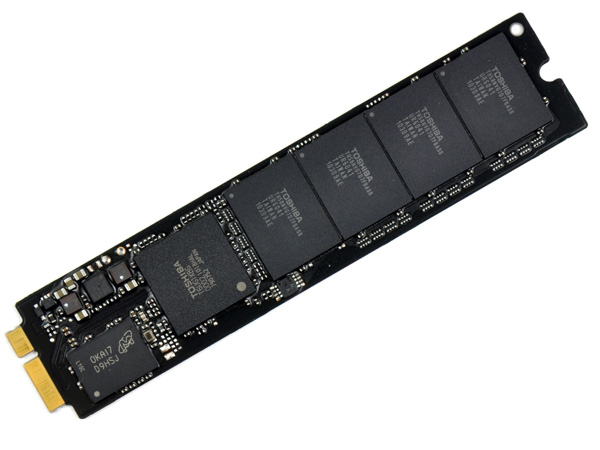
The 11-inch MacBook Air SSD, courtesy of iFixit
The SSD isn’t in an industry standard form factor, although the connector appears to be either micro or mini SATA. Presumably 3rd party SSD manufacturers (ahem, SandForce partners I’m looking at you) could produce drop in replacements for the MacBook Air SSD.
There’s nothing particularly innovative about the form factor of the SSD, other than Apple did away with the unnecessary space a 2.5” SSD would require. Just as SSDs will break the traditional SATA interface barriers, we’ll see the same happen to form factors as well.
The part number on the Toshiba controller may look familiar to some of you. It’s the same controller that’s in Kingston’s SSDNow V+ Series and the SSDNow V Series Boot Drive. I reviewed the latter not too long ago and found that it was a good drive for the money, and here’s the kicker: the SSDNow V Series Boot Drive was amazingly resilient when written to without TRIM support. Its performance hardly dropped as a result of normal desktop use. This is very important because although OS X 10.6.4 has a field for reporting TRIM support on an SSD, the instruction isn’t actually supported by the OS. Even the new MacBook Airs don’t ship with a version of OS X with TRIM support.
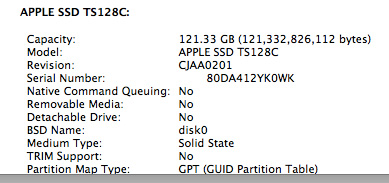
The SSD only has four NAND devices on it. Typically that would mean some very low transfer speeds, particularly on writes. But each one of those four devices has at least 16GB of NAND, spread across multiple planes and die. With the right firmware, you should be able to extract a good deal of parallelism from this architecture. Apple and Toshiba apparently do just that.

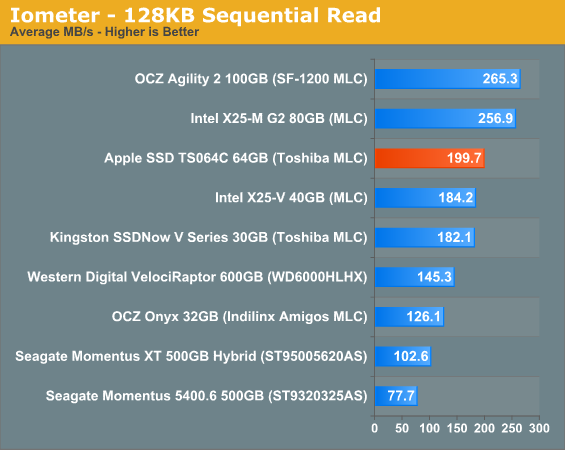
While most value SSDs top out at under 100MB/s, we get nearly 200MB/s sequential reads and writes out of the SSD in the new MacBook Air. And fortunately, Apple hasn’t only focused on sequential performance. The random read/write performance of the new MacBook Air SSD isn’t terrible:
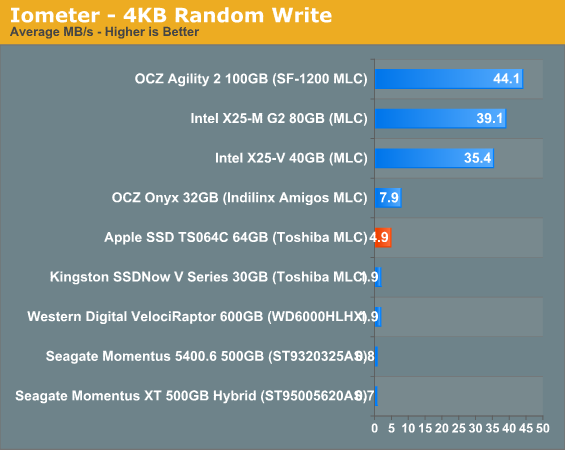
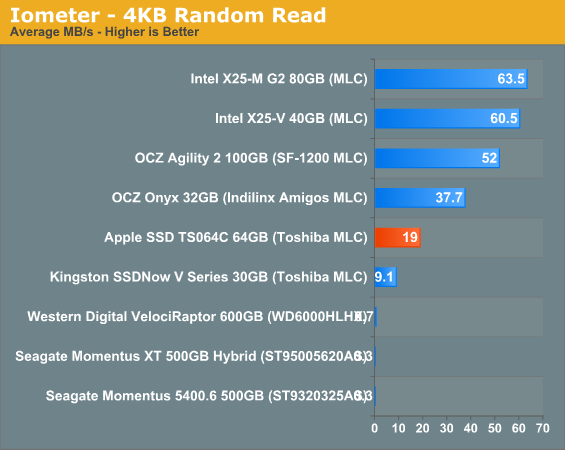
Random write performance is of course the weak point, but you’ll notice that it’s actually higher than the Kingston drive that uses the same controller. While Apple would’ve been better off striking a deal with Intel or SandForce for the controller in the MacBook Air, the Toshiba controller isn’t horrible.
As I mentioned earlier, resilience is very important as OS X still doesn’t support TRIM. I filled the drive with garbage and then tortured it for 20 minutes with random writes. The resulting performance drop was noticeable, but not unbearable:
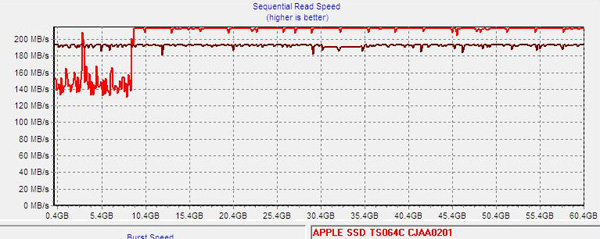
A single pass of sequential writes restores performance to normal:
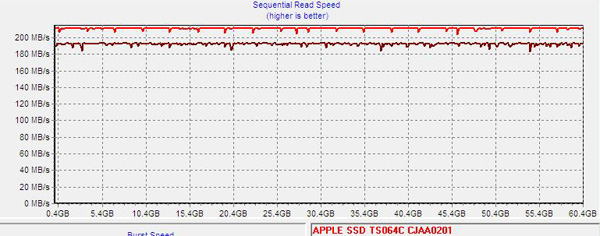
This tells us two things. First, through normal use the drive should be able to recover its performance over time (assuming you give it enough spare area). And second, if there’s any idle garbage collection in Apple’s custom firmware for the Toshiba controller it should be able to keep the drive running at peak performance even without TRIM supported in the OS. I don’t have a good way of measuring whether or not there’s GC enabled on the drive in OS X, but I suspect Apple is (at least it appears to be doing so on the Mac Pro’s SSDs).
Overall I’m pleased with Apple’s SSD selection. It could’ve been a lot better but it could’ve been a lot worse. The MacBook Airs in their default configuration have better IO performance than any other standard config Mac sold on the market today, including the Mac Pro.










185 Comments
View All Comments
cabjf - Tuesday, October 26, 2010 - link
The fact that the iPad will easily sync with your main computer does give it one advantage over the Air. If Apple produced some type of easy to use syncing software so that you could use the Air as a portable version of your main computer's contents, it would be the perfect road companion to an iMac, Mac Pro, or even a 17-inch Macbook Pro. Perhaps that is the way they are moving in bringing an App Store and other iOS features to Mac OS X. Maybe that's part of the intended use for that huge data center they are building (and already considering expanding).wintermute000 - Wednesday, October 27, 2010 - link
" If Apple produced some type of easy to use syncing software so that you could use the Air as a portable version of your main computer's contents, it would be the perfect road companion to an iMac, Mac Pro, or even a 17-inch Macbook Pro."Easily done with a bit of work
- know where the files are and don't do things like let itunes sort folders
- rsync or any decent gui backup/sync software
storage is an issue but for work purposes 64Gb is enough to handle it
for streaming media use streaming media solutions.
psonice - Wednesday, October 27, 2010 - link
Apple sell 'mobile me' which pretty much does this. It gives you an 'iDisk' in the cloud, accessible from any of your machines (think it supports windows too?), plus there's an iphone app to access it. It also syncs your bookmarks, preferences, dock icons (don't think it syncs the actual apps though) and keychain (for passwords). There's push email + web hosting (main thing I use it for) and other bits too.It's $60/year, and it's possible to get pretty much everything for free elsewhere. But like a log of apple stuff, it works well, it's nicely integrated, and if you have the money it's not worth arsing around with the others.
Tmoz - Wednesday, October 27, 2010 - link
You could use Dropbox to do this: http://db.tt/eiXQTsi (Disclosure: Referral link)It syncs your files to Amazon S3 and then to any computers you have the software installed on (Mac/Windows/Linux are supported)
dendysutrisna - Friday, August 12, 2011 - link
Yes I understand, since this article was made when Apple's MacBook Air which has been reinforced Intel Core i5 has not come out. MacBook Air the latest generation, which has been paired with Mac OS X Lion, there is a AirDrop feature, where you can share with computer around you which in one network, even with the computer windows though. Try to look http://www.bestdealscomputers.net/netbooks/apple-m... I've made a little review about the newest MacBook Air, you might want to find out more.quiksilvr - Tuesday, October 26, 2010 - link
Seriously, their pricing scheme makes absolutely no sense. I have attempted to see what COULD be the decent price point, but a few points have to be made:1) The Macbook 13 (the white one) simply needs to die.
2) They are now hitting 4 different screen sizes, and IMO they should stick to three and make things easier (as should other PC makers)
1) 12" screen (not 11.6", 12") for the netbook market
2) 14" screen for the general market
3) 16" screen for the heavy multimedia and desktop replacement market
3) Get rid of the "Pro" terminology. Simply have it Macbook 12, 14, 16 and Air versions of these models (Macbook Air 12, etc.)
4) STOP forcing customers to get the "upgraded" version just so that we can upgrade the CPU. This is annoying and very Dell like and customers don't like it.
martyrant - Tuesday, October 26, 2010 - link
Apple has needed a price overhaul since the company's inception.Glad you are only now realizing.
darwinosx - Tuesday, November 2, 2010 - link
You are just too dumb to understand that similar quality, service, and a modern OS from other companies is as much or more than Apple products. Except they don't have a modern OS.quiksilvr - Tuesday, October 26, 2010 - link
Okay, here is my attempt (and I know this will never happen because it makes too much sense)Macbook Air 12: $799
Macbook 12: $599
Macbook Air 14: $999
Macbook 14: $799
Macbook Air 16: $1199
Macbook 16: $999
And as shocking as this may seem to Mac users, this is still a major premium over PCs.
Macbook Air Baseline:
-Core i3 LV (or ULV) with Core i5/i7 LV/ULV option (add thickness if necessary)
-Integrated Intel HD chip and dedicated nVidia card with Optimus
-SSD (I would say start it at 90GB and work your way up)
-USB 3.0 all the way
-mini Displayport with choice of adaptor included (DVI, VGA, HDMI, Displayport, etc.)
-Wireless, Bluetooth, yada yada
-4 GB RAM
-No Optical
-And one thing I just noticed, put an actual microphone PORT and put a stereo microphone next to the webcam
-Expresscard Slot option
Macbook Baseline:
-Core i3 with Core i5/i7 option (add thickness if necessary)
-Integrated Intel HD chip and dedicated nVidia card with Optimus
-HDD with SSD option (start HDD with 250GB)
-USB 3.0
-mini Displayport with choice of adaptor included (DVI, VGA, HDMI, Displayport, etc.)
-Wireless, Bluetooth, yada yada
-4 GB RAM
-DVD Burner with Blu Ray Player/Blu Ray Burner option
-Expresscard Slot option
5) And for the love of god, stop making these screens epic glossy. This is a message to ALL PC makers! Make it half and half or give a realistically priced matte option (FREE)
solipsism - Tuesday, October 26, 2010 - link
Nothing you wrote makes sense.How much is the ULV CPU from Intel?
How much is the LV CPu from Intel?
How much is that Nvidia 320M?
How much does it cost to mill an aluminum case?
How much are 9.5mm ultra-slim slot-loading BRDs?
Can you find any for sale?
Which Core-i3 LV and ULV chips will they use?
Which USB3.0 controller will they use, how much will cost, where will go in the Airs?
Where will this ExpressCard slot go?
Why scrape the 11, 13 and 15” Mac notebooks for 12, 14 and 16” displays?
Why didn’t you fail to address the size, weight, or quality of anything? You just took a price that you compared to other vendors, bumped it slightly and then added a whole mess of features without considering engineering, costs, or anything else. You might as well add include TARDIS technology to fit all that in there and/or use a TARDIS to go into the future to a time when all that is actually possible, but instead you just sound like a TARD in your self proclaimed “makes too much sense” post.